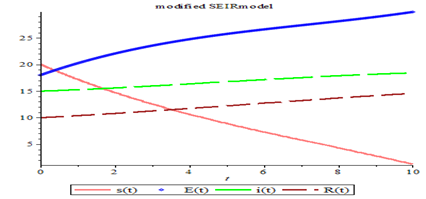NUMERICAL SIMULATION AND ANALYSIS OF A CAPUTO FRACTIONAL-ORDER SEIR MODEL FOR COVID-19 PREVALENCE USING THE HERMITE POLYNOMIAL COLLOCATION AND LAPLACE-ADOMIAN DECOMPOSITION METHODS
Keywords:
Hermite Polynomials, Collocation Methods, Simulations Analysis, Laplace-Adomian Decomposition Method, SARS-CoV-2 VariantsAbstract
COVID-19 poses major public health challenges due to its high transmissibility. This study presents a novel numerical framework based on a fractional-order SEIR model to explore serotonin transfer and evaluate control strategies for emerging SARS-CoV-2 variants. By including the exposed compartment, the extended SEIR model offers improved insight into variant transmission dynamics. Two advanced numerical techniques are compared: the Hermite Collocation Method (HCM) and the Laplace-Adomian Decomposition Method (LADM). Due to the model's inherent nonlinearity, finding exact solutions is difficult. To overcome this, the model is transformed into a nonlinear algebraic system using Hermite polynomial collocation with Caputo fractional derivatives. Expansion coefficients representing the approximate solution are computed with Maple software, enabling precise analysis of disease dynamics. The fractional derivative framework captures memory effects that influence transmission, particularly under changing viral conditions. Simulations reveal that both methods effectively reduce transmission and hospitalizations, but HCM outperforms LADM in accuracy and convergence speed. The results demonstrate the strength of fractional-order modeling in describing real-world epidemic patterns, especially with evolving COVID-19 variants. HCM’s high reliability positions it as a valuable predictive tool for health authorities. Its precision allows for early detection of outbreaks and supports the formulation of responsive public health strategies. This study emphasizes the importance of advanced mathematical modeling in managing infectious diseases and recommends HCM as a reliable method for anticipating variant behavior. Policymakers can apply this approach to develop timely, adaptive interventions for future COVID-19 variants and similar pandemics.

Published
How to Cite
Issue
Section
Copyright (c) 2025 Morufu Oyedunsi Olayiwola, Ajimot Folasade Adebisi, Bosede Abubakre, Akeem Olarewaju Yunus

This work is licensed under a Creative Commons Attribution 4.0 International License.
How to Cite
Most read articles by the same author(s)
- Mutairu Kayode Kolawole, Ajimot Folasade Adebisi, Atinuke Abidemi Adeniji, A NOVEL CAPUTO FRACTIONAL-ORDER MODEL OF CHOLERA TRANSMISSION WITH BEHAVIORAL AND IMMUNOLOGICAL DYNAMICS USING THE LAPLACE–ADOMIAN DECOMPOSITION METHOD , FUDMA JOURNAL OF SCIENCES: Vol. 9 No. 9 (2025): FUDMA Journal of Sciences - Vol. 9 No. 9




